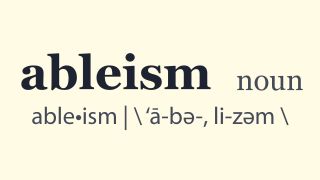Bias
What Is Ableism? A Social Psychological Perspective
An introduction to the social psychology of ableism.
Posted December 29, 2023 Reviewed by Monica Vilhauer
Key points
- Ableism involves stereotyping, prejudice, and discrimination toward people with disabilities.
- People with disabilities are often stereotyped as warm but incompetent.
- Stereotypes about people with disability can lead to behaviors of patronization or neglect.

The term ableism is gaining momentum. For instance, the National Institutes of Health is now calling for research on the effects of ableism on disabled people's health. But what does ableism actually mean, according to psychology?
Defining Ableism: Some Key Terms
Ableism can be defined as stereotyping, prejudice, or discrimination toward people with disabilities. Ableism, like other forms of bias against social groups, is an attitude. It can be implicit or explicit, subtle or overt.
The ABC's of Attitudes
According to social psychology, attitudes are composed of three parts, and they can be remembered with the acronym ABC.
Colloquially, people often use the terms stereotyping, prejudice and discrimination interchangeably, but they actually have specific meanings in psychology that correspond to the ABCs of attitudes.
- Stereotyping is about cognition, or beliefs that certain attributes are characteristic of numbers of particular groups.
- Prejudice is based in affect, or negative emotions about numbers of a particular group.
- Discrimination refers to behavior acting on stereotyping or prejudice.
Dimensions of Warmth and Competence
A theory from social psychology, the Behavior from Intergroup Affect and Stereotypes (BIAS) Map, suggests that most stereotypes, prejudice, and discrimination follow a predictable pattern.
This theory states that we form stereotypes about people based on two dimensions, their perceived warmth (e.g. friendliness, kindness, and trustworthiness) and their perceived competence (e.g. capability and intelligence). There are adaptive reasons to form these quick impressions. We want to know as soon as we encounter someone if they are a friend or foe, and if they could be helpful or harmful.
Disabled people, along with children, older adults, and women, are stereotyped as warm but incompetent. This is called the paternalistic stereotype cluster, because these groups are viewed as low status, unable to help themselves, and in need of protection.
Cognitions of warmth and incompetence elicit emotions of pity. That is, because people with disabilities are viewed as incapable, their "unfortunate" situation is perceived as not their fault. Stories and media are full of depictions of disability as pitiable, such as the newly disabled main character in Me Before You, who feels so sorry for himself that he believes he is better off dead than a burden to others and kills himself.
Emotions of pity lead to behaviors of active facilitation (e.g. patronizing help) or passive harm (e.g. neglect or avoidance). A common example of patronizing help is when bystanders jump in to "help" a person with a disability who did not ask for or need it. Passive harm can involve excluding people with disabilities, failing to provide accommodations, or passing them up for job or promotion opportunities.
As a side note, you may be curious about the other stereotype clusters. You can view a figure showing all the warmth-competence combinations here. People who are stereotyped as cold and incompetent include houseless people and welfare recipients. This elicits contempt and harmful behavior. Those who are stereotyped as cold yet competent (e.g. CEOs, model minorities) are the subjects of envy which can prompt hostile acts. Finally, those who are judged as both warm and competent are admired, and people try to emulate or affiliate with them. Oprah is a classic example of someone who is often viewed in this admirable stereotype. There is a reason her book club and "favorite things" are so popular!
The stereotype content model illustrates that disability is but one of many social identities that we have stereotypes about. it's helpful to think about similarities across "isms" like ageism and sexism that we might learn from. There is a dearth of research on ableism and ageism—studying one can likely help us fight the other.


